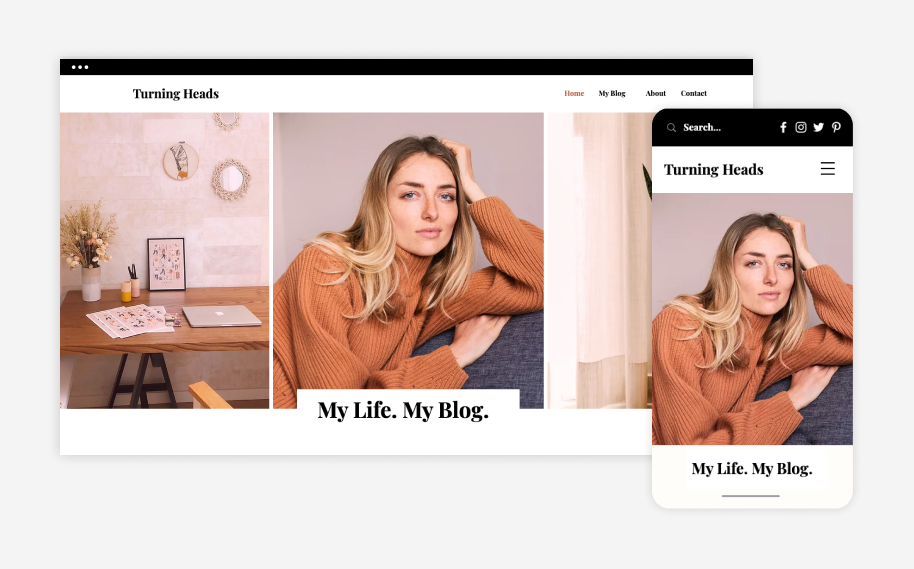How to Increase Website Traffic
Search, social, email, and more ideas for driving visitors to your website.

In today’s world, creating a website is one of the most important steps toward small business success. It’s the foundation that allows you to build an online presence and grow your business.
After all, you can learn a lot about the people who visit your website and turn them into an advocate, partner, or client with the right set of tools. If any of these things happen, it’s a win. Now, how do you get visitors to your website?
Try the following approaches to learn how to increase website traffic.
Table of Contents

1. Optimize your content with keywords
When you optimize your content with keywords relevant to your business, the process is known as search engine optimization (SEO). Many business relationships are formed after someone types a word or phrase into a search engine to find a website. Knowing the search terms people use to discover your website makes it easier to draw in more visitors. Certain terms may be specific to you, such as a brand or product name. Or, they can be attributes or benefits like “all-natural,” “free delivery,” or something else that sets you apart.
In Google Analytics, you can view what terms your website visitors have used to find you in the past and use those keywords to help you optimize your website content. It’s also a good idea to look at the terms your competition uses on their websites, in social media, or in emails.
Google Search Console is another free tool you can use to see how often your website appears in search results, which search terms drive the most visitors, and how many people click on your site in search results.
2. Create targeted landing pages
Directing a website visitor to a dedicated landing page featuring just what they’re interested in helps them engage with your website and, ultimately, your business. Use website analytics to create pages that highlight content tailored to website visitors’ priorities. This might look like a special promotion based on the posts someone’s been reading or updates on new features of a product they’ve been researching.
You can build this personalized messaging into your ongoing marketing by creating tags for your contacts. A tag is a label for a contact that can inform the content you serve up when they visit to ensure that it’s relevant.
Craft compelling content that resonates with your audience
Find out how to create irresistible content that solves problems, teaches skills, and keeps your audience engaged and coming back for more.

3. Proven Strategies to Increase Website Traffic Effectively
Driving traffic to your website is crucial for online success, whether you run a blog, an e-commerce store, or a business website. To increase website traffic, start by optimizing for search engines (SEO). Conduct thorough keyword research to target the right audience and improve on-page SEO by optimizing meta titles, descriptions, headings, and images. Technical SEO also plays a vital role, so ensure your site loads quickly, is mobile-friendly, and is properly indexed by search engines. Building high-quality backlinks from authoritative websites further enhances your search rankings and drives organic traffic.
Creating high-quality content is another effective way to attract visitors. Publishing valuable, well-researched, and engaging content consistently helps establish credibility and encourages repeat traffic. Diversify your content by including blogs, videos, infographics, and case studies. Using long-tail keywords strategically can help your content rank higher for niche search queries, making it easier for users to discover your website.
Leveraging social media marketing is essential for reaching a wider audience. Sharing your content on platforms like Facebook, Twitter, LinkedIn, and Instagram increases visibility and engagement. Actively participating in discussions, responding to comments, and using trending hashtags can enhance your social media reach, ultimately driving more visitors to your website. Running paid advertisements, such as Google Ads and social media ads, provides an instant traffic boost by targeting specific demographics and increasing brand awareness.
Email marketing remains a powerful tool for increasing website traffic. Building an email list with lead magnets and sending regular newsletters with valuable insights keeps your audience engaged and encourages them to visit your website frequently. Personalized emails with compelling subject lines and clear calls to action (CTAs) can significantly improve click-through rates and conversions.
Collaborating with influencers and guest blogging can also expand your reach and bring in new visitors. Getting featured on high-authority blogs in your industry exposes your content to a broader audience, while inviting guest bloggers to contribute to your site adds fresh perspectives and attracts their followers. Partnering with influencers to promote your content or products can lead to increased credibility and website traffic.
Monitoring website analytics is essential to track performance and refine your strategies. Using tools like Google Analytics helps identify traffic sources, high-performing content, and areas that need improvement. Updating old content with fresh information, optimizing underperforming pages, and consistently implementing best SEO practices ensure long-term growth and sustained traffic.
Increasing website traffic requires a strategic combination of SEO, content marketing, social media engagement, paid advertising, email marketing, and collaborations. By implementing these techniques consistently, businesses can boost their online presence, attract more visitors, and achieve long-term success. Would you like me to further refine this content or add internal links for better SEO optimization
4. Be mobile-friendly
Device-use is ubiquitous, so even Google has started not only indexing the mobile version of your website, but also using that version to rank sites. That means mobile-optimized blogs get an extra SEO Boost. Thankfully, if you use Wix, your blog websites templates come with mobile-friendly design and navigation by default.

5. Post frequently
Starting a blog involves some work. You can’t expect to write one blog post and wait for the visitors to start rolling in. Blogging is a bit like going to the gym: It’s hard to do it regularly, but the benefits are huge. We’re not saying you need to write a 3,000-word post every day, but you can start by publishing weekly or bi-weekly.
From our experience, blogging more frequently can greatly impact blog SEO. When you provide those hungry Googlebots with your fresh and updated content, they will keep on coming back for more. Plus, you give the search engine more opportunities to rank your pages.
The key to posting more frequently is simple: Be organized. A posting schedule can help you make your blog plan a reality. In an Excel sheet, create a table that includes each blog post’s publishing date, writing deadline, some references and your target keywords. Having a good overview will make you feel more in control and encourage you to stick to your schedule.
To take some of the work off of you, consider inviting other experts in the field to write guest posts or hire freelancers to outsource some of the heavy lifting.
6. Engage on social media
Although not commonly known for its SEO power, social media can help get your name (and your links) out there. By sharing your valuable, original and well-written blog posts on Twitter, LinkedIn, Instagram, Facebook and more, you increase the chances that someone will amplify your content.
Search engines perceive that extra amount of traffic from social as a signal that others respect your blog, which can do wonders for your blog’s SEO.
The easiest way to do this is to add a “share” and Twitter Tweet button in your blog posts, so your readers can easily post about them. Also, don’t forget to share your published blog posts on your own social channels: Use the Social Media Graphics tool’s incredible ready-made templates to customize and create extra buzz about your posts.
7. Link internally
Ever wondered how a Googlebot gets from one page to another? Probably not. But we’ll let you in on that secret: Links. Indeed, links are like a spider’s web behind the scenes of your website’s pages. When you link from one blog post to another page within the same domain (sitename.com), search engine bots (also known as “spiders”) can more easily discover all of your site’s pages and scan the content from head to toe. This process is called “crawling.” Once crawled, the web pages are saved in a massive library, aka “indexed.”
Websites with blogs have 434% more indexed pages than those that don’t. The more blog posts in your library, the higher the chances of your pages appearing on search results for a relevant query.
Adding more internal links also allows your visitors to browse your site freely, facilitating clicks to more pages. This signals to search engines that your website’s content satisfies its audience, and you’ll get a good blog SEO boost for it.
Pro tip: Instead of using “click here” or “read this,” use descriptive anchor text when linking to an internal blog post. This gives more context and makes it easier for the search engine to understand what’s on the upcoming page.
About the Author

Abhishek Kumar Jaiswal
With a 15th year of experience in digital marketing, training, and entrepreneurship, Abhishek Sir has a rich background, including a stint as Brand Manager for top notch companies, leading over 1000+ sessions for students and corporates, and spearheading the Placement Cell at corporate. His entrepreneurial journey includes co-founding a venture with IIT graduates. At DigitalNaukri, he is at the forefront of strategy, growth, product development, team building, placements, and enhancing the student experience.